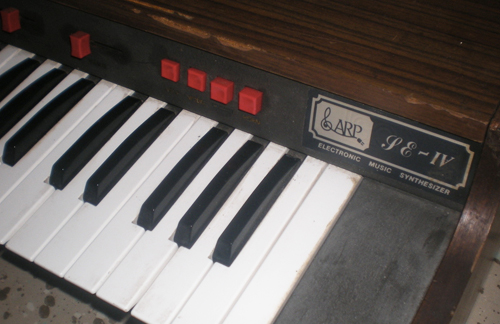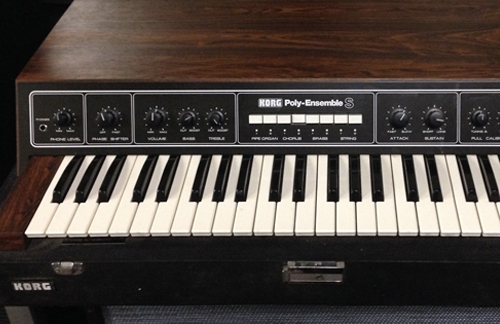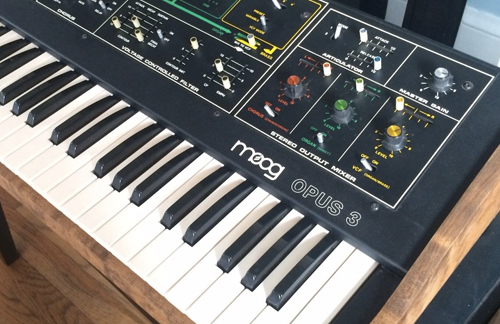From Joy Division's “Love Will Tear Us Apart,” to the cheesy, sleazy smooth funk of many an adult-film soundtrack, string synthesizers were responsible for one of the defining sounds of the late '70s and early '80s.
String synthesizers served their intended purpose as a budget alternative to recording full-string ensembles on disco hits like the Bee Gees' “Nights on Broadway” and blazing funk jams like Nu Shooz's “I Can't Wait,” but studio explorers like Jean Michel Jarre and Tangerine Dream also were using them to imagine the sounds of the cosmos.
The era for string synthesizers was brief, as they were more or less a stepping stone technology between the compact organ and the polyphonic synthesizer. The guts of these machines are very similar to those of organs like the Farfisa Compact series: oscillators generating and combining tones at different frequencies to create complex timbres, run through amplitude envelopes to give those sounds certain shapes, from percussive attacks to long decays.
The string ensemble sound on these synths is actually generated by an analog delay that creates the illusion of multiple oscillators playing ever so slightly out of time with one another, just as two violin players would strike their bows microseconds apart. Controls were basically limited to presets and effects levels.
String synths were a success at the time because they were the first widely-distributed synthesizers you could play chords on, but they were swiftly eclipsed by polyphonic synthesizers like the Sequential Circuits Prophet 5 and the Yamaha DX7, which were much more sonically flexible.
Yet string synths have experienced a resurgence in popularity this century precisely because they do one thing and do it well: lush, cosmic, analog warmth. Here’s a look at seven noteworthy string synths that still offer interesting sounds and command our attention.
Elka Rhapsody

Boasting some of the original string synthesizers, and in turn some of the most popular, the Rhapsody series was produced by the Italy's Elka for five years from 1975 to 1980. Models like the 310, 490 and 610 all can switch between an organ section and a string section, a type of flexibility that would be left by the wayside as competition in the field multiplied. Elka wasn't distributed much in the United States, but it filled Europe with organs, string synthesizers and electric pianos throughout the '70s. The company also was responsible for the low-key legendary Synthex, a massively powerful analog poly synth that still sells for as much as $9,000 today.
Roland RS-202

Generally regarded as one of the best sounding string synthesizers ever made, the RS-202 spawned a nearly exact clone in the Multivox MX-202. In the '70s, one company ripping off another's design and selling it in a different market was a pretty common practice. Ibanez, famously, made exquisite clones of Fender guitars and sold them in East Asia. The inverse happened with the RS-202. As told by SoundOnSound, the Japanese company Roland didn't have the resources to protect its designs overseas, and Multivox used the look and much of the circuitry from the RS-202 for its own product sold in the United States. The RS-202 is all about flexibility, with its keyboard split into two sections, each of which can be assigned a different string sound. In addition to a delay, the RS-202 featured vibrato and innovated with the addition of a chorus for a different type of ensemble effect.
Siel Orchestra/ARP Quartet

The groundbreaking synth company ARP is most famous for its duophonic Odyssey, which was recently reissued by Korg. But the company got its start in the keyboard market buying and rebranding a design by an Italian company, Siel. Vintage Synths notes that there were virtually no modifications to the design. The Siel Orchestra utilized a common sound-generating technique for string synths called divide-down synthesis. What this means is that 12 oscillators are each used to produce a note in the highest octave of the synth. The lower pitches are produced by those high frequencies being divided in half over and over, all the way down to the bottom octave. The Orchestra, and later the Quartet, were widely used in disco, but it will forever be outshone by ARP's other string synth, the Solina.
ARP Solina String Ensemble

Many feel that ARP perfected the string synthesizer with its Solina, which sounds just as sexy as it looks. Unlike many string synthesizers from the time, its variety of orchestral timbres all sound great, from the violin to the trumpet to the contra-bass. No corners are cut in its feature set, offering all of the bells and whistles an organ-based string synth could: an attack/decay envelope, delay and chorus. Like the ARP Quartet, it generates sound through divide-down synthesis. Also like the ARP Quartet, it was not an original ARP design.
The Solina was actually based on the 310U Organ, designed and manufactured by the Dutch outfit Eminent. Granted, ARP did a lot more work on the redesign of the Solina than it did the Quartet, meaning that the Solina is less a repackaging of the Eminent 310U Organ than an evolution of it. According to SoundOnSound, one of the Solina's big selling points at the time was that you could hold a chord on it forever, while many competitors of the era had a finite-sustain envelope. The Solina remains popular today because, well, it still sounds incredible.
Korg Polyphonic Ensemble S

Finding a champion in Greek prog rock and new-age luminary Vangelis, the Korg Polyphonic Ensemble S was manufactured long before Korg was anything like the electronic instrument titan it is today. At the time, the company was still going by Keio Organ, which is where the portmanteau “Korg” comes from, and the Polyphonic Ensemble was its first polyphonic synthesizer. Two models were manufactured, the P and the S, but the S is the much-more interesting one, featuring the lush, cosmic string sounds that made it particularly well-suited to studio experimentation. While it sounds very good, the Polyphonic Ensemble S just so happened to be a stepping stone to much more advanced machines for a company that would become one of the industry's biggest.
Moog Opus 3

The very company that first attached a keyboard to a synthesizer had its own take on the string synthesizer that, unlike the majority of the competition, was not just a modified organ. The Moog Opus 3 is based on presets like all string synths, but the flexibility of its controls far outmatches any other, in my opinion.
Unlike the majority of string synth manufacturers, Moog was not an organ company. Its reputation for innovation seemed to compel Moog to equip the Opus 3 with full control over the voltage-controlled filter, modulation section and chorus depth. It even featured an envelope offering control over attack, sustain and decay in contrast to the lion’s share of other manufacturers that only offered control over attack and decay. While this is by far the most flexible string synth ever made, the company released it late in the game. By the time of its manufacture in 1980, the string synth market was saturated and polyphonic synthesizers were on the rise, a revolution started by Moog's competitor Sequential Circuits with its Prophet 5.
Waldorf Streichfett
Ever since the German synthesizer outfit Waldorf returned to the scene in 2007, it has made a name for itself designing low-cost, compact synthesizers with magnificent sound. In 2013, the company started a line of square, black, tabletop synthesizers that you can throw in a backpack, including its own string synthesizer the Streichfett.
Featuring both a bank of string sounds and a bank of electric keyboard sounds, the Streichfett is an all-in-one source for vintage keyboard sounds that does a very good reproduction of machines from the late '70s and early '80s. While it does require a MIDI keyboard to play, the Streichfett is aimed at the musician who doesn't want to bother lugging a computer around to play VST reproductions of vintage synths and also doesn't want to bother with the upkeep of a four-decade-old keyboard. All in all, a convenient little device that emulates its ancestors very well.
